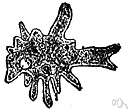amoeba
(redirected from amebae)Also found in: Thesaurus, Medical, Encyclopedia.
a·moe·ba
also a·me·ba (ə-mē′bə)n. pl. a·moe·bas or a·moe·bae (-bē) also a·me·bas or a·me·bae
Any of various one-celled free-living or parasitic protozoans having no definite form and moving by means of pseudopods.
[New Latin Amoeba, genus name, from Greek amoibē, change, from ameibein, to change; see mei- in Indo-European roots.]
a·moe′bic (-bĭk) adj.
American Heritage® Dictionary of the English Language, Fifth Edition. Copyright © 2016 by Houghton Mifflin Harcourt Publishing Company. Published by Houghton Mifflin Harcourt Publishing Company. All rights reserved.
amoeba
(əˈmiːbə) orameba
n, pl -bae (-biː) or -bas
(Animals) any protozoan of the phylum Rhizopoda, esp any of the genus Amoeba, able to change shape because of the movements of cell processes (pseudopodia). They live in fresh water or soil or as parasites in man and animals
[C19: from New Latin, from Greek amoibē change, from ameibein to change, exchange]
aˈmoebic, aˈmebic adj
Collins English Dictionary – Complete and Unabridged, 12th Edition 2014 © HarperCollins Publishers 1991, 1994, 1998, 2000, 2003, 2006, 2007, 2009, 2011, 2014
a•me•ba
or a•moe•ba
(əˈmi bə)n., pl. -bas, -bae (-bē).
1. any of numerous one-celled aquatic or parasitic protozoa of the order Amoebida, having a jellylike mass of cytoplasm that forms temporary pseudopodia, by which the organism moves and engulfs food particles.
2. a protozoan of the genus Amoeba, inhabiting bottom vegetation of freshwater ponds and streams: used widely in laboratory studies.
[1875–80; < New Latin amoeba < Greek amoibḗ change, alteration, n. derivative of ameíbein to exchange]
a•me′bic, adj.
a•me′boid, adj.
Random House Kernerman Webster's College Dictionary, © 2010 K Dictionaries Ltd. Copyright 2005, 1997, 1991 by Random House, Inc. All rights reserved.
a·moe·ba
(ə-mē′bə) Plural amoebas or amoebae (ə-mē′bē)
A one-celled microscopic organism that constantly changes shape by forming pseudopods, temporary projections that are used for movement and for the ingestion of food. Amoebas are members of the group of organisms called protozoans.
The American Heritage® Student Science Dictionary, Second Edition. Copyright © 2014 by Houghton Mifflin Harcourt Publishing Company. Published by Houghton Mifflin Harcourt Publishing Company. All rights reserved.
ThesaurusAntonymsRelated WordsSynonymsLegend:
Switch to new thesaurus
| Noun | 1. |  amoeba - naked freshwater or marine or parasitic protozoa that form temporary pseudopods for feeding and locomotion amoeba - naked freshwater or marine or parasitic protozoa that form temporary pseudopods for feeding and locomotionrhizopod, rhizopodan - protozoa characterized by a pseudopod endameba - any ameba of the genus Endamoeba |
Based on WordNet 3.0, Farlex clipart collection. © 2003-2012 Princeton University, Farlex Inc.
Translations
амеба
amøbe
amööb
amebat
ameba
amőba
amebaamoeba
amöba
Collins Spanish Dictionary - Complete and Unabridged 8th Edition 2005 © William Collins Sons & Co. Ltd. 1971, 1988 © HarperCollins Publishers 1992, 1993, 1996, 1997, 2000, 2003, 2005
Collins English/French Electronic Resource. © HarperCollins Publishers 2005
amoeba
, (US) ameban → Amöbe f
Collins German Dictionary – Complete and Unabridged 7th Edition 2005. © William Collins Sons & Co. Ltd. 1980 © HarperCollins Publishers 1991, 1997, 1999, 2004, 2005, 2007
Collins Italian Dictionary 1st Edition © HarperCollins Publishers 1995
amoeba
, ameban. ameba, organismo de una sola célula.
English-Spanish Medical Dictionary © Farlex 2012
amoeba
n (pl -bae o -bas) ameba or amibaEnglish-Spanish/Spanish-English Medical Dictionary Copyright © 2006 by The McGraw-Hill Companies, Inc. All rights reserved.